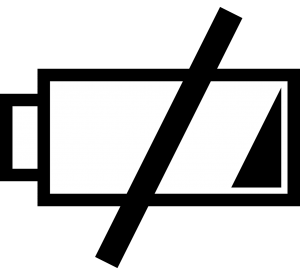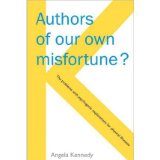The other day, I was struggling, as many of us with chronic illness do, to explain myself to a friend. As usual, I had to give up. I can’t explain to her why it’s not perfectly easy for me to drive in and out of my nearest city (an hour’s drive each way, a quarter of which is on narrow, twisty rural roads) several times – or even once – a week. I’ve tried using the spoon theory, which makes a lot of sense to me, but I don’t seem to be so good at explaining it to others, and people often don’t want to or have the time to follow links and read articles that you send them.
I don’t claim to have invented the battery analogy – I’ve seen it many times before, particularly in connection with Myalgic Encephalomyelitis, the neurological disease I suffer from. But today, possibly because I just recently got a new laptop, with a much longer-lasting battery than its predecessor, I suddenly felt like I could use it to make a good explanation of what it’s like to have ME and other chronic illnesses – something that I and others could show to our friends and family members to help them understand.
Imagine two laptops, or smartphones, or tablets. Both have a battery. Each battery can only recharge once in a 24 period. One has a charge that lasts for 20 hours, the other 5 hours. This is a pwME (person with ME) versus a healthy person.
But it gets more complicated than that. There’s something called boom and bust. Imagine a pwME wants to go away for a weekend and be out of bed for 14 hours a day for three days – I’m planning to do this myself in a couple of weeks. (I will be attending a conference: having breakfast in the hotel with friends; going to talks during the day; and having dinner together in the evening.) But that means you need to find 27 extra energy hours somewhere.
Maybe you can use some of those backup battery packs? Maybe you can get 5 hours out of each of them. So, 6 of them should be more than enough, with a few extra hours for emergencies. But they all need to be recharged overnight (19 hours) also.
AND YOU ONLY HAVE ONE CHARGER!!!
So, in order to add those 27 extra hours to your weekend, you are going to have to spend 19 x 6 (114) extra hours in bed. This will obviously have to come out of the five hours a day when you are currently not resting. You do the maths! (I was being rhetorical there, I am actually going to do the maths. 🙂)
114 divided by 5 is almost 23. That’s how many days, at minimum, you will have to be bed bound to recover from your three days of activity. More than 3 weeks. And I am actually being very conservative with the figures here. You could easily add another week to that. And some activities will use up the batteries faster than others, making your energy debt even greater.
That’s how it works. And, although I am writing from my own experience as a pwME, it works the same way for many other chronic illnesses.
So next time you see a chronically ill person attending a party, going out for a day, or even having a weekend away, don’t think to yourself “She must be getting better/he can’t be that bad really/how come they can find the energy to do the things they really want to do?”
Instead, do the maths. Your chronically ill friend will still be paying the price days, weeks, or months afterwards – long after the party, event, or holiday has faded from your memory.
Mary Tynan
Previously published in The Mighty and Yahoo Lifestyle (as Teresa Ledwith) under the title The Best Analogy to Explain ‘Energy Debt’ With Chronic Illness.


